Gear For Salmon Fishing: A List Of Everything You Need
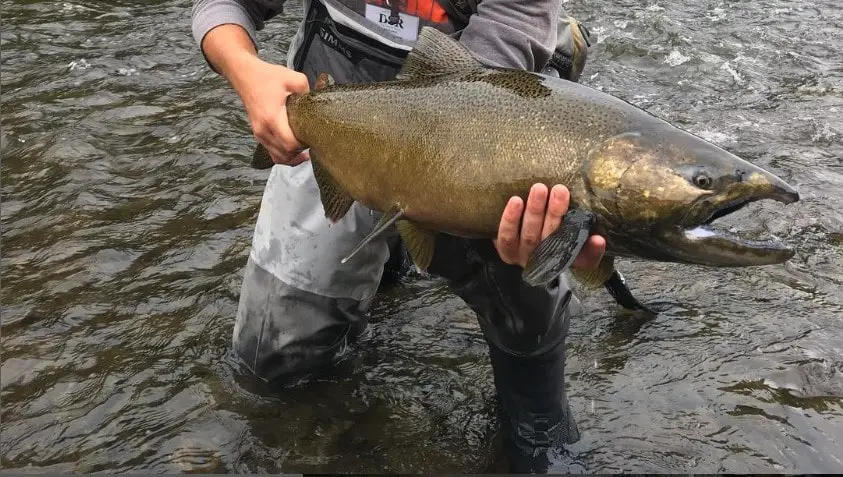
The gear for salmon fishing will depend on the method or the type of salmon fishing that you want to do, such as spin fishing, baitcast fishing, float fishing, and fishing from the boat using methods like trolling and mooching.
The essential salmon fishing gear for all methods includes a rod, reel, line, leader, hooks, pliers, and a net. Other gear will include waders, a wading jacket, and a vest or pack for river fishing. On the boat, you may require different gear.
Key Takeaways
| Key Point | Details |
|---|---|
| 1. Essential Gear: | Rod, reel, line, leader, hooks, pliers, net, and extra gear as needed. |
| 2. Spinning Rod and Reel: | Suitable for shore and river fishing; select the right size for the salmon type. |
| 3. Fishing Lines: | Braided, monofilament, or fluorocarbon lines for different salmon methods. |
| 4. Terminal Tackle: | Use weights, swivels, and hooks; choose weights based on your fishing style. |
| 5. Lures and Baits: | Utilize twitching jigs, spinners, spoons, and various baits for success. |
| 6. River Fishing Methods: | For river fishing, consider floats, bobbers, waders, boots, jackets, vests, and specific river gear. |
| 7. Ocean/Lake Fishing Gear: | Trolling rods, reels, downriggers, divers, and suitable lines for deeper waters. |
Spinning Rod And Reel Gear For Salmon Fishing
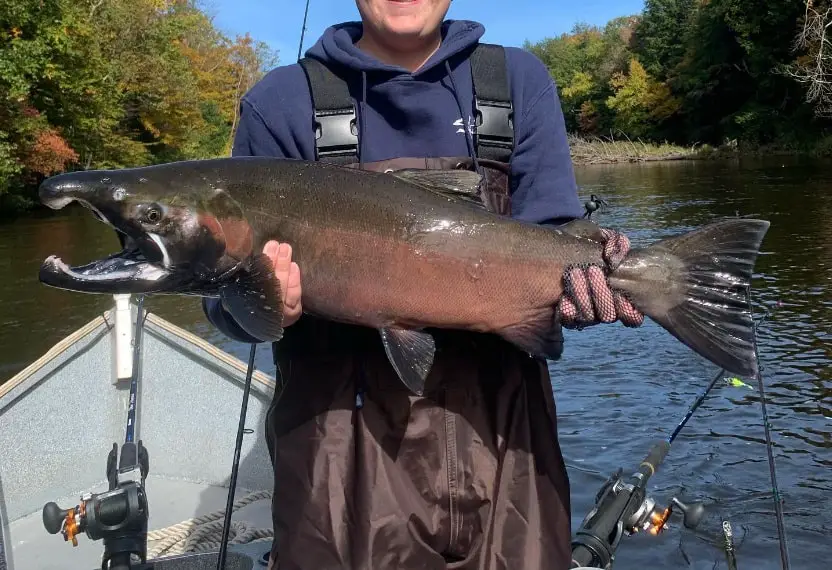
A spinning rod and reel combo is a great option for salmon, but use them in the right places and be sure they are suitable for the size of salmon you are fishing for. Spinning rods and reels are suitable for:
- Fishing from shore or along the river.
- Fishing for big or strong salmon like big Coho, Chum, or King salmon – just be sure it’s heavy enough to handle the fish.
- Pink salmon and sockeye salmon fishing is good with a lighter spinning rod and reel.
- Spinning Rods and Reels are budget-friendly and are cheaper than other rods and reels such as bait casting reels or Centerpin reels.
Remember that a pink salmon averages 3 to 5 pounds, and a Chinook salmon could weigh over 50 pounds and average 30 pounds. Even a Coho salmon of 12 pounds will rip a ton of line off a spinning reel, so the salmon you are targeting will greatly affect the type of fishing gear salmon anglers will need.
Spinning Rod
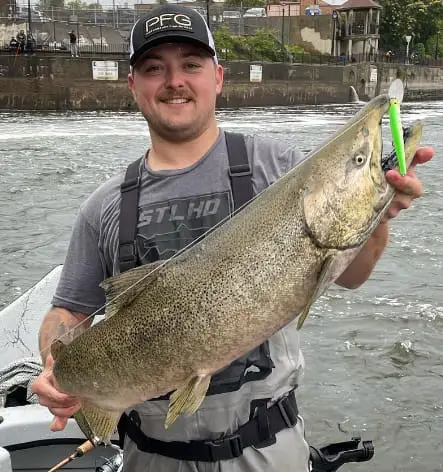
When river fishing, I won’t need as heavy a rod as I would out on the Great Lakes or while saltwater fishing for salmon.
General Purpose Salmon Rod: For river fishing with lures, jigs, or still fishing with bait, I use medium or medium-heavy spinning rods that are about 7.6 feet to 8.6 feet in length.
That’s plenty to catch sizable salmon while fishing in a drift boat, casting from the shore or pier, or wading in a river or stream.
Big Rivers: When I am primarily fishing for big kings in larger faster rivers, I use bigger heavy to extra heavy rods and 8 to 8.5 feet long.
Bigger rods give me plenty of fighting power to land a bigger fish while salmon fishing. The added length also helps to give more clearance from the boat when battling a big fish.
Float Fishing With Baits: For float fishing for big salmon, I use longer rods with a line rating of 8 to 15-pound test. The rod length I use is 13 to 14 feet for most conditions.
Spinning Reel
Salmon are strong fighters and they need a reel with a very good drag to help me and my clients land the big ones. When fishing for coho or chum salmon, I do fine with a size 30 to a size 40 reel that holds up to between 150 and 250 yards of line. A max drag of 17 to 22 pounds is good.
Catching big Chinook on large rivers, from piers, and coastal shorelines, I use heavier equipment, like size 40 to 50 reels that hold about 300 yards of line. The max drag should be around 22 pounds or more to help tire out a big one.
Fishing Lines
There are three types of fishing lines used for salmon fishing.
Braided Fishing Line
A major advantage of braided fishing line is that it has high-test strength but is a thin diameter line, and therefore, I can fit more line on the reel.
The thin diameter cuts the water better and allows me to get the lures deeper in the water column.
Braided line strength-rated for between 30- and 50-pound test is good for salmon. I use a lighter line when fishing for smaller pink salmon and sockeye salmon.
Anglers use braided line for most salmon fishing methods.
Monofilament Line
Mono has been catching salmon for 50-plus years. It’s simple, basic, and the least expensive of all the lines. The downside is it is thicker than braided line so I can’t get as much on the reel, and it has up to 8% stretch. Some anglers prefer mono over other lines, however, mono works with all salmon fishing methods.
Fluorocarbon Line
The Fluorocarbon line is an ideal line for making leaders and some anglers will use it as their mainline, especially when casting lures or using still fishing methods like Plunking.
It’s very tough, has almost no stretch to it, and is nearly invisible — even in clear water.
Terminal Tackle
Weights
Depending on the fishing method, I will add some weight to the line to help get it down to the desired depth while fishing and help hold the line in place against any current. The weight is important for float fishing, drift fishing, and plunking methods.
Split shots are small round weights used for float fishing.
Pencil lead or slinkies are used for drift fishing and plunking. Specialty weights are also sometimes used for methods like Mooching Salmon.
I also like egg weights that let the line slip through the middle and place the weight just above the swivel, which I secure with either a uni knot or a Palomar knot.
Swivels
The swivel is important to make it easier to change leaders as needed. I like to use a barrel swivel with a snap on one end that I use to attach lures.
In some setups, a three-way swivel is also used to hang a dropper weight off the leader.
Hooks
The important thing with hooks is to use ones that won’t break or bend when fighting large salmon. I match the hook size to the size of the bait. Standard hooks range from size 1/0 to size 6. The octopus hook is the most common type of hook for bait fishing.
Lures – Twitching Jig / Spinner / Spoon
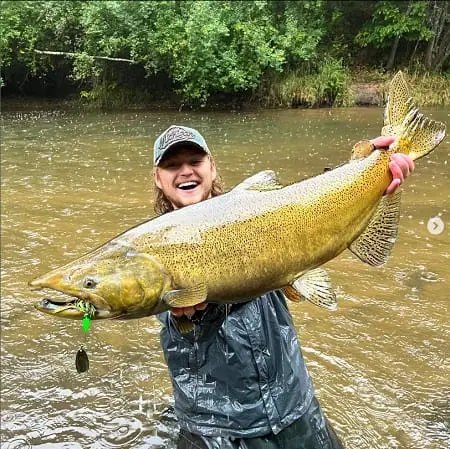
I use spinners and spoons, which might be the most popular lures to use for salmon fishing. Crankbaits, plugs, and jigs are also effective and commonly used salmon fishing tackle.
Baits For Salmon
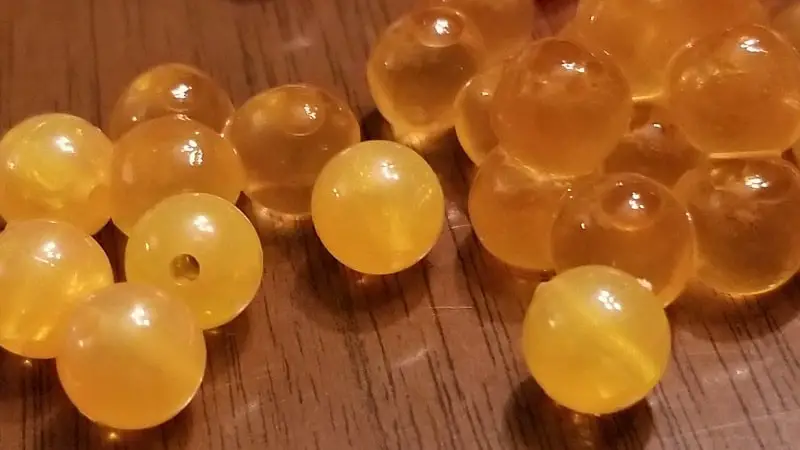
Baits are not considered basic gear, but, they will help catch salmon or steelhead in rivers and streams. You should consider having these baits on hand.
- Egg sacs
- Beads
- Skein
- Shrimp
- Flies
- Worms
Baitcasting Rod and Reel Gear Setup For Salmon
If you ever watch fishing shows, you might have noticed that baitcasting rods and reels are the preferred salmon fishing gear, especially when trolling the deeper waters.
Baitcasting Reels
Round: There are three types of baitcasting reels to consider. There are the large round baitcasting reels, which are good for trolling and drift fishing.
Low Profile: The low profile baitcasting reels are being used a lot more for river fishing methods like back bouncing, back trolling, and even casting lures. The smaller profile is just easier to use.
Line Counter: The line counter reels are best for anglers who want to be more precise when fishing to get the required lure depth or length. Line counters are great for trolling methods and mooching.
Casting Rod
The casting rod is specially designed to be used with a baitcasting reel. The line is on top of the rod, and there is a stopper knob on the bottom for better grip and to prevent the rod from slipping out of the hand.
Rod length and size depend on the method. Medium-heavy or heavy casting rods from 7.5 feet long to 10 feet are common.
Lines For Baitcasting Reels
I can use the same lines as spinning reels for wading in rivers or streams, but some anglers might want to use copper or lead core lines while trolling for salmon.
Fly-Fishing Gear Setup For Salmon
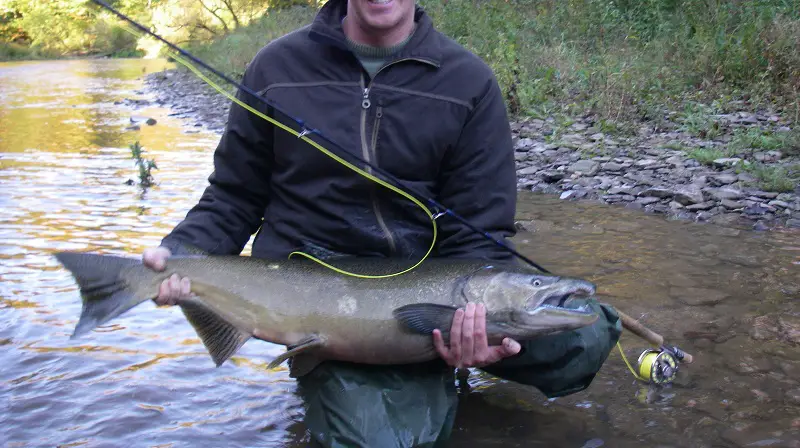
Fly Rods
Nine-foot fly rods rated for 8-weight to 10-weight with fast action work great. For anglers that like to nymph, 10-foot rods are best. Heavier rods are best for large rivers, while light 8-weight rods are good for smaller rivers or great lakes salmon fishing.
Fly Reels
I match the fly reel with the rod weight for an ideal setup.
Fly Line: The fly line also needs to match the rod and reel weight. Most anglers use floating fly lines designed for salmon and steelhead.
Fly Leaders: An 0x or stronger leader made for salmon is best
Fly Tippets: Because salmon are strong and have teeth, I use a thicker fluorocarbon tippet. The tippet will depend on the method being used. When Nymphing, a litter tippet is often required, but when swinging flies or streamer fishing, a heavy tippet over 16 pounds is good.
Other General Salmon Gear For River Fishing
Floats and Bobbers
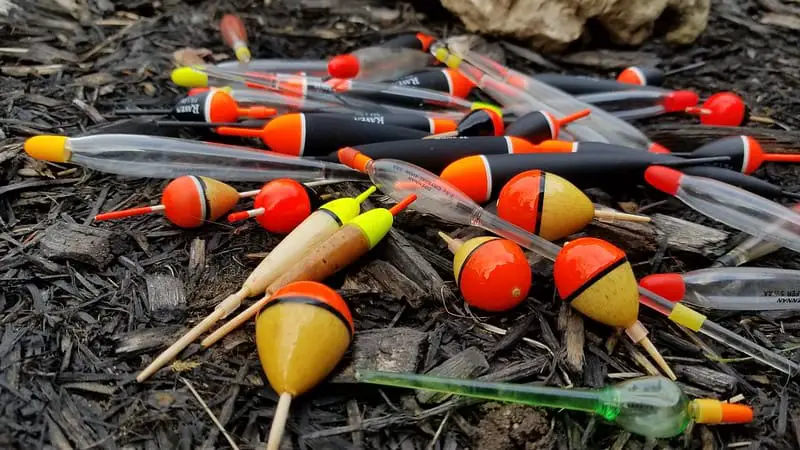
Floats and slip bobbers are commonly used by anglers to hook into salmon and steelhead in rivers and streams.
Bobber Stopper(s)
Bobber stoppers are used with slip bobbers and make it a lot easier to adjust the depth when float fishing.
Waders and Wading Boots
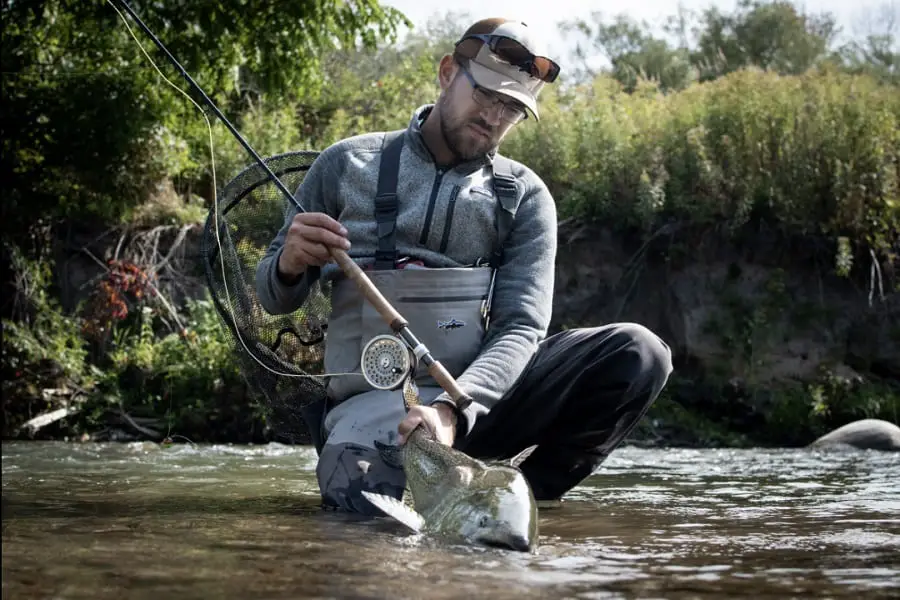
Waders and wading boots with gravel guards help stay dry and warm while searching for your trophy fish. Chest waders are preferred over hip waders.
Wading Jacket
A wading jacket keeps you dry and warm in cooler weather while river fishing.
Vest or Packs
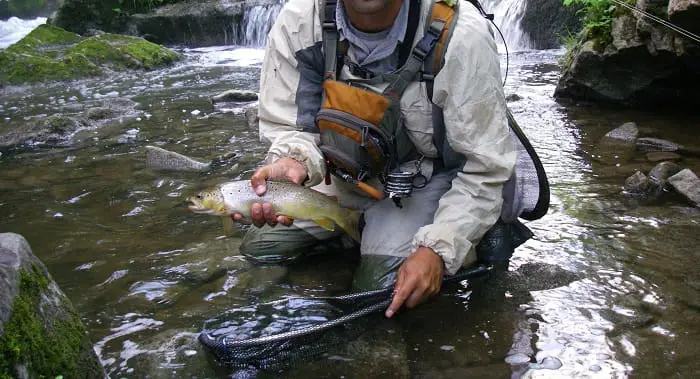
A fly fishing vest or pack is what i use to keep gear and fly boxes handy while wading in rivers and streams.
Net
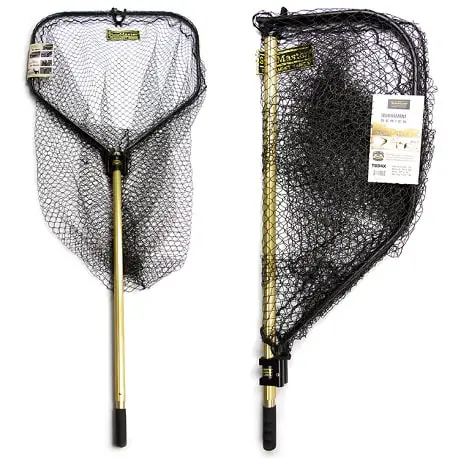
All salmon and steelhead anglers need a good net sized appropriately to thew size of the salmon to help land a fish. See Best Salmon Nets.
Pliers or Fishing Forceps
Salmon have sharp teeth that you don’t want anywhere near your hand or fingers. Pliers or forceps help an angler remove hooks quickly without risking injury.
Gear For Talking Salmon Home to Eat
Stringer
Two kinds of stringers are available. One is made from braided nylon and the other type of stringer is a steel chain with several large metal snaps attached. Stringers are used to secure and transport fish out of the river.
Knife
A good fillet knife makes quick work of separating the meat from the rest of the salmon and its skin and scales. A powered filet knife can make quick work of fileting several fish at the boat ramp so you can place the filets in a cooler that contains ice.
Bleed Bucket
A bleed bucket will hold the blood and guts of a freshly gutted salmon. I use the blood and guts to chum salmon or other fish.
Garbage Bag
When I don’t want to bring a cooler with me, I will put my salmon in a garbage bag to keep the slime out of the vehicle.
Cooler
A cooler with ice will help to preserve the salmon until I get home.
Ocean and Lake Fishing Gear For Salmon
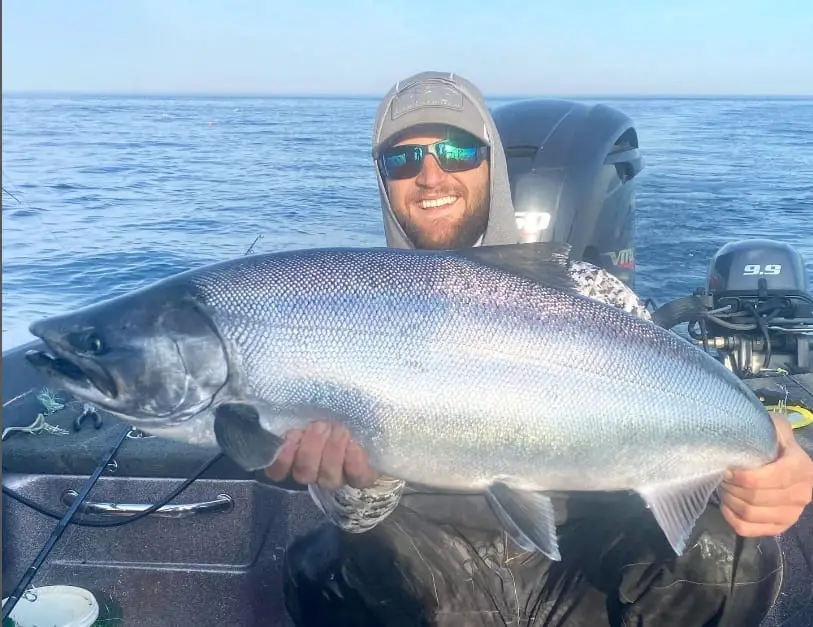
Whether I am fishing on the ocean, the Great Lakes, or one of the many large inland lakes in North America, some basic salmon gear will help anglers have more success.
Trolling Rods
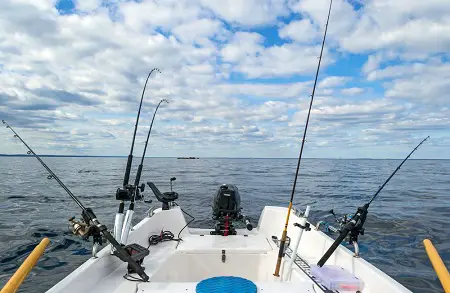
Trolling rods are generally longer and heavier, so they can put the line where I need it while giving good clearance from the vessel.
They are longer than downriggers and make for great salmon fishing gear when fishing in deeper waters.
Trolling Reels
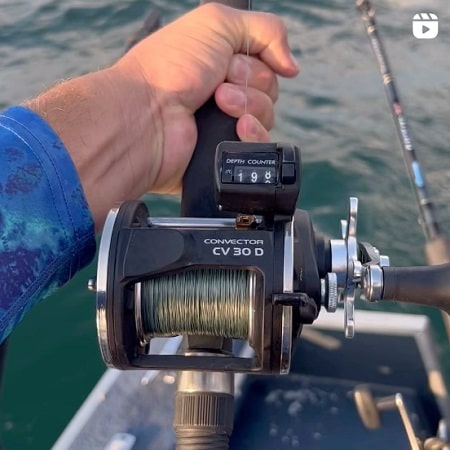
Trolling reels are line counter baitcasting reels that hold a lot of line so that Ican fish very deep waters or long lines, with the help of a significant amount of weight, downriggers, or maybe some divers.
The drag has to be strong to help fight a big fish that might get hook while on a salmon fishing trip.
Downriggers
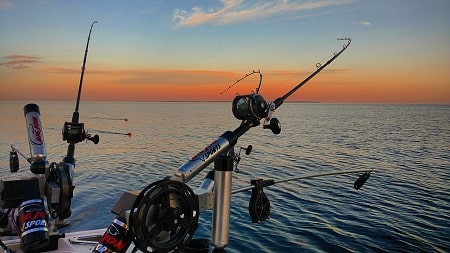
Downriggers are essential fishing gear for trolling and help to put the lure or cut-bait at the same depth as the fish. The downrigger rods are shorter than casting rods or spinning rods but are much sturdier.
Divers: Dipsy Divers and Jet Divers
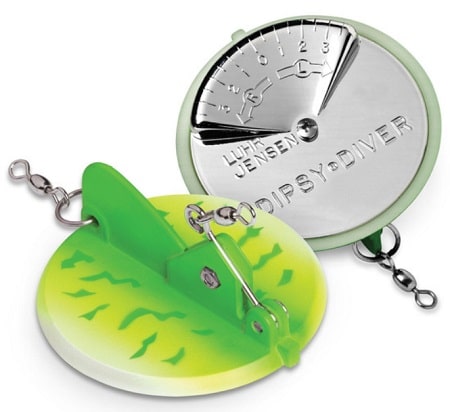
Many lures won’t go deep, so a dipsy diver or a jet diver can help achieve depths up to 80 feet.
Dipsy divers and jet divers attatch to the line to get the lure or bait down to the proper depth. The can also be set to run left or right to spread out the lines and cover more water.
Flashers and Dodgers
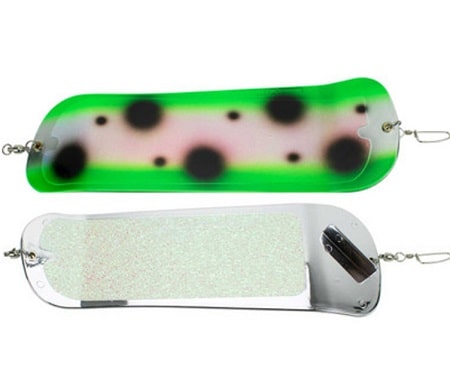
Flashers and dodgers are steel that have a plastic or metal rudder located near the head to keep the line from twisting while fishing. Flashers also help to give your lure or bait some action that could help attract fish while trolling.
Snubbers
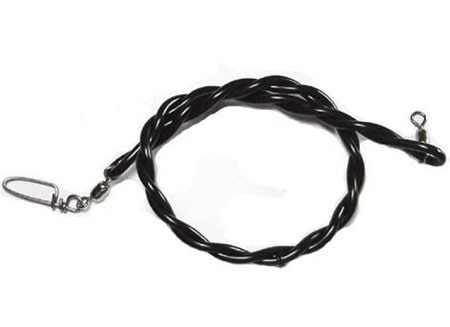
A snubber goes between the diver or flasher and the lure or between the lure and the downrigger ball. Snubbers absorb some of the shock the fish hitting the lure hard preventing the lure from being ripped out of the fish’s mouth.
Lines For Trolling Salmon
- Monofilament: A type of line made from a single strand of material, such as nylon. It has some stretch to it and resists abrasion, which makes it a great line for salmon fishing tackle.
- Braided Line: Braided line is made from multiple strands of material that are braided together to make an especially strong but light and thin line. Many of the best use eight strands, but some use as few as four.
- Lead core: The line has an inner core of lead contained within a sheath of Dacron line that is braided. Lead core line helps to get your lures to the right depth while angling offshore.
- Copper Line: The heaviest and strongest trolling line, it has several strands of copper that are wound into one single strand of copper line.
Sonar Unit
The sonar unit is especially important for fishing success out in the open water. It helps to find fish beneath the surface and can show you their depth, the number of fish in the area, and their general size.
Sonar units also help you locate structure and baitfish which are often keys to finding feeding salmon.
If you are drift fishing, the sonar can help you know when to drop anchor and target a school of fish.
GPS
GPS is important if you are heading out on a boat and need to know your exact position. It also can help you to pinpoint productive water.
Marine Radio
A marine radio is your lifeline if something goes wrong with the boat while you are fishing. You can use it to call for help and get a Coast Guard response if your boat is sinking or someone has a medical emergency while on board.
Tight Lines
Graham
